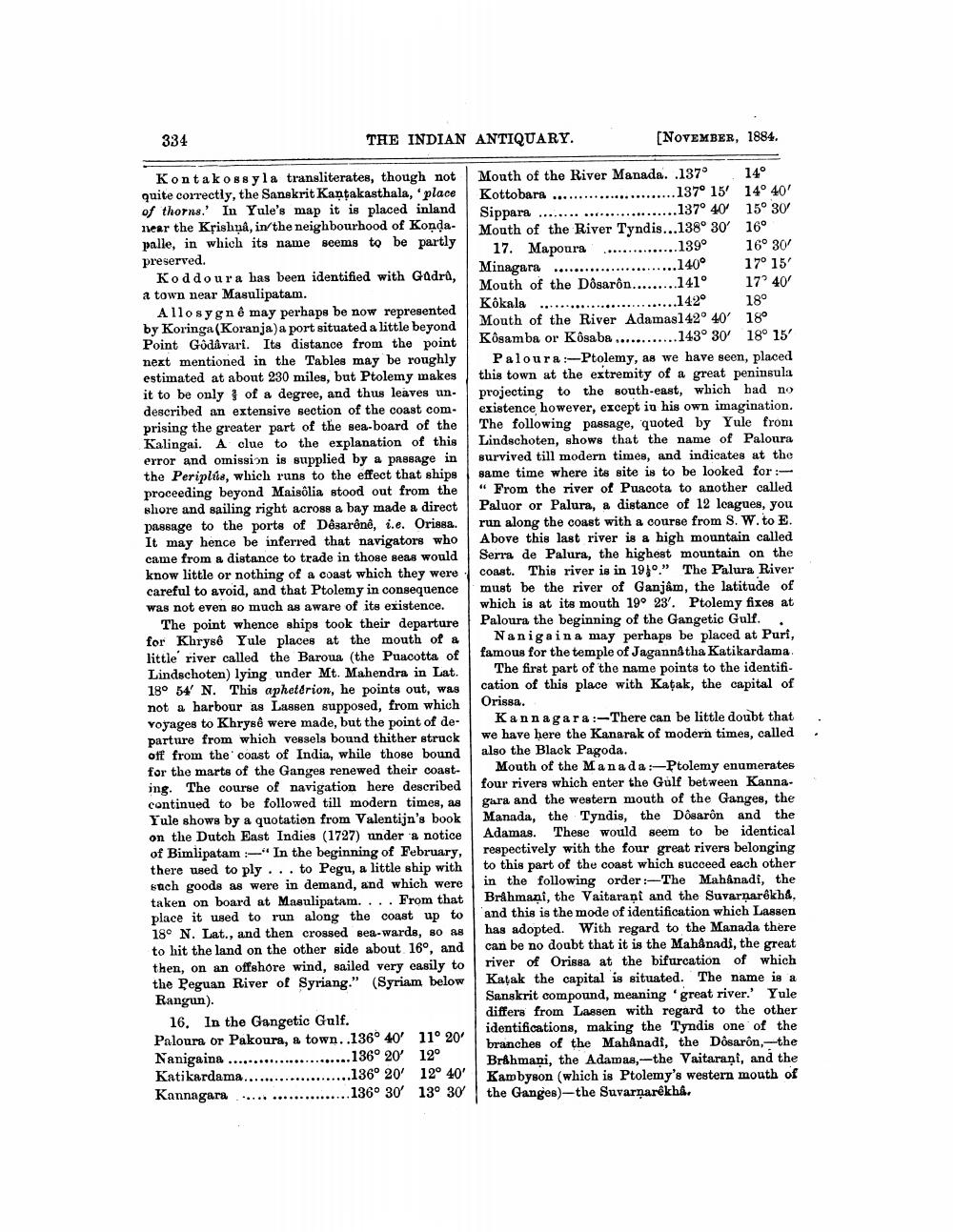________________
334
THE INDIAN ANTIQUARY.
(NOVEMBER, 1884.
Kontakossyla transliterates, though not quite correctly, the Sanskrit Kantakasthala, 'place of thorns.' In Yule's map it is placed inland near the Krishna, in the neighbourhood of Kondapalle, in which its name seems to be partly preserved.
Koddoura has been identified with Gadra, a town near Masulipatam.
Allo sygnê may perhaps be now represented by Koringa (Koranja) a port situated a little beyond Point Godavari. Its distance from the point next mentioned in the Tables may be roughly estimated at about 230 miles, but Ptolemy makes it to be only of a degree, and thus leaves un. described an extensive section of the coast com. prising the greater part of the sea-board of the Kalingai. A clue to the explanation of this error and omission is supplied by a passage in the Periplís, which runs to the effect that ships proceeding beyond Maisolia stood out from the shore and sailing right across a bay made a direct passage to the ports of Désarând, i.e. Orissa. It may hence be inferred that navigators who came from a distance to trade in those seas would know little or nothing of a coast which they were careful to avoid, and that Ptolemy in consequence was not even so much as aware of its existence.
The point whence ships took their departure for Khrysê Yule places at the mouth of a little river called the Baroua (the Puacotta of Lindschoten) lying under Mt. Mahendra in Lat. 18° 54' N. This aphetérion, he points out, was not a harbour as Lassen supposed, from which voyages to Khrysê were made, but the point of departure from which vessels bound thither struck off from the coast of India, while those bound for the marts of the Ganges renewed their coasting. The course of navigation here described continued to be followed till modern times, as Yule shows by a quotation from Valentijn's book on the Dutch East Indies (1727) under a notice of Bimlipatam :-"In the beginning of February, there used to ply ... to Pegu, a little ship with such goods as were in demand, and which were taken on board at Masulipatam.... From that place it used to run along the coast up to 18° N. Lat., and then crossed sea-wards, so as to hit the land on the other side about 169, and then, on an offshore wind, sailed very easily to the Peguan River of Syriang." (Syriam below Rangun).
16. In the Gangetic Gulf. Paloura or Pakoura, a town. .136° 40' 11° 20' Nanigaina ........................136° 20' 12° Katikardama..... ...........136° 20' 12° 40' Kannagara .....................136° 30' 13o 30
Mouth of the River Manada. .137° 14° Kottobara ............ ........137° 15' 14° 40' Sippara ........ .........137° 40 150 30 Mouth of the River Tyndis...138° 30 16° 17. Mapoura
...........139° 16° 30' Minagara ........................140° 17° 15 Mouth of the Dôsarôn.........141° 17° 40 Kökala .......... ..........142° 18° Mouth of the River Adamas142° 40' 18° Kosamba or Kósaba .............143° 30' 18° 15'
Paloura :-Ptolemy, as we have seen, placed this town at the extremity of a great peninsula projecting to the south-east, which had no existence, however, except in his own imagination. The following passage, quoted by Yule from Lindschoten, shows that the name of Palourn survived till modern times, and indicates at the same time where its site is to be looked for : "From the river of Puacota to another called Paluor or Palura, a distance of 12 leagues, you run along the coast with a course from S. W. to E. Above this last river is a high mountain called Serra de Palura, the highest mountain on the coast. This river is in 1910." The Palura River must be the river of Ganjâm, the latitude of which is at its mouth 19° 23'. Ptolemy fixes at Paloura the beginning of the Gangetic Gulf. .
Nanigaina may perhaps be placed at Puri, famous for the temple of Jagannatha Katikardama
The first part of the name points to the identifi. cation of this place with Katak, the capital of Orissa.
Kannagara:-There can be little doubt that we have here the Kanarak of modern times, called also the Black Pagoda.
Mouth of the Manada Ptolemy enumerates four rivers which enter the Gulf between Kannagara and the western mouth of the Ganges, the Manada, the Tyndis, the Dosaron and the Adamas. These would seem to be identical respectively with the four great rivers belonging to this part of the coast which succeed each other in the following order :-The Mahanadi, the Brahmani, the Vaitarani and the Suvarnarékha, and this is the mode of identification which Lassen has adopted. With regard to the Manada there can be no doubt that it is the Mahánadi, the great river of Orissa at the bifurcation of which Katak the capital is situated. The name is a Sanskrit compound, meaning great river.' Yule differs from Lassen with regard to the other identifications, making the Tyndis one of the branches of the Mahanadi, the Dosaron,--the Brahmani, the Adamas,-the Vaitarani, and the Kambyson (which is Ptolemy's western mouth of the Ganges)-the Suvarnarêkha.
. .




